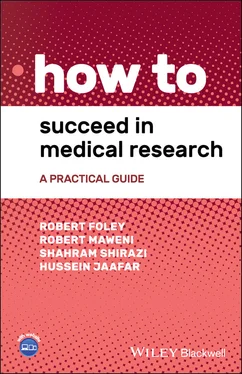Therefore, it may be best to form what we term a ‘pseudo‐collaborative’. This is a small group of individuals who may share the same interest in a topic as you but are at other geographical locales and have different key skills and knowledge to bring to a research project.
Case Study 1.4 Learning outcomes in surgery collaborative [4]
I decided to pursue my interest in the teaching of surgical skills to Foundation Year 1 (FY1) doctors. This was important to me because this was the level at which I was working, and I was keen to find the best and easiest way to acquire surgical skills to help me on the way to becoming an ENT surgeon. I discussed this with my mentor, a foundation training programme director who was also a surgical consultant, and we came up with a curriculum of work‐based assessments that, we felt, would prepare FY1 doctors for surgical training as well as allow them to enjoy their surgical FY rotations.
With the idea formed, it was important to recruit team members with expertise and reach that I lacked. I created a PowerPoint presentation with the idea and pitched it to colleagues at my level with greater statistics and recruitment expertise than I, as well as my former professor of surgery, all of whom I found to be receptive. The paper was later published, with data from across the UK and Ireland, which would not have been possible if working without collaboration.
1.3.7 Case–control study and cohort study
Original research is arguably the most important type of research to perform and should be the goal. The first step in original research will be to identify an interesting clinical question and then design a study to attempt to answer the question. For example, if we consider migraine‐type headache, we could ask: what is the relationship between patients' migraine headache and patient clinical features? Are there any risk factors that predispose patients to migraine headache, such as age or weight? We can then look at a group of patients with migraine and a group of patients without migraine and compare the findings in both groups. This would be termed a ‘case–control study’. These sorts of studies are retrospective in design and look back at risk factors in patients with a defined outcome (i.e. a diagnosis of migraine headache or not). Case–control studies can be an excellent starting point for original research because they are cheap and easy to perform.
In contrast to this, cohort studies look at a population of patients and compare those who were exposed to something and those that were not and then see what the outcomes are in each group. A classic example of this type of research is the Framingham Heart Study [5], which began in the 1940s. This study followed large numbers of patients from the beginning of the study and waited to see which patients developed heart disease. The researchers then looked back at the clinical features that differed between those patients who developed heart disease and those patients who did not. This study found correlations between heart disease and risk factors such as smoking, high cholesterol, and high blood pressure. The disadvantage of this type of study is that it requires large amounts of funding and takes a long time to conduct. Therefore, although this type of research can be very valuable, it is not the ideal place to start.
1.3.8 Randomised controlled trial
A randomised controlled trial (or RCT) is a very important study design utilised in medical research. It involves recruiting a cohort and randomly assigning the patients in the study to receive one treatment or another. In a double‐blind trial design, the patients and the researchers also don't know which treatment the patient has been assigned. These trials are the best method of determining the optimal treatment strategy for patients in medicine. This method is commonly used in oncology for comparing new cancer treatments to the current gold standard treatment.
1.3.9 Systematic review and meta‐analysis
This type of research involves summarising all of the research that has already taken place on a particular topic. There is a very detailed methodology to follow in conducting this sort of research, and the meta‐analysis is also carried out in a particular fashion. This type of research can be very time‐consuming when performed for the first time, but it can be an excellent way to gain an in‐depth understanding of a topic and can also be very useful if you cannot identify a research question for a piece of original research.
1.4 Clinical vs laboratory
There is an important distinction between clinical and laboratory research. Clinical is undoubtedly easier to perform if you are new to research. Laboratory research is usually undertaken as part of a research degree, or sometimes an extended period of time is allocated to a research project in medical or biomedical degrees. Laboratory research takes time and can rarely be properly performed on a part‐time basis while attempting to continue your regular studies or work. Laboratory research is discussed in more detail in Chapter 10.
1.5 Getting ideas for research
The ideas needed for research will depend on the type of research you plan to perform. For example, ideas for a case report or a case series may arise from time spent meeting patients in clinic or on the wards. Ideas may come from discussing your interest in getting involved in research with a senior colleague (more in Chapter 2), or you may not need to come up with the idea at all, such as in the case of a collaborative project.
Ask yourself: what interests or excites me in research? This is one of the main things to bear in mind when thinking of ideas for your research. It can be difficult to stay motivated in research at times; however, if you pick a topic that you have genuine interest in, it will be far easier to continue with the project until the end. Another excellent way to get ideas for research is to draw on the experience of your seniors. Try to identify those people who have been involved in research in the past and discuss it with them. What led them to become involved in research? How did they start? Who did they talk to? This kind of discussion can be very important, and if your senior is receptive, then you can use this person as a role model/mentor over the course of your research career.
Case Study 1.5 Identifying areas for research
I had the idea for a research study in patients with acoustic neuroma (a brain tumour) because a family member of mine was diagnosed with the condition. I obviously had a big interest in this disease, and I was particularly interested if patients with this tumour experienced a big impact on their quality of life. I discussed the idea with a colleague of mine, and this project was also perfect for him, as it allowed him to demonstrate his interest in ear, nose, and throat surgery, because that is who commonly looks after patients with acoustic neuroma. But we didn't know much about quality of life in research, so we asked for help from our hospital's psychiatric team, particularly concerning how to perform a quality of life assessment, and they gave us ideas of questionnaires we could use. From there, we spent some time reviewing the literature on the topic. We found that some research had been conducted on the topic, but that we could approach it from a different angle. We were interested in whether the quality of life was different in patients who had undergone a different treatment strategy, and if alcohol was used as a coping mechanism. We thought that our question was clinically interesting, and we decided that we would proceed to the next step in this study and try to identify a supervisor for the project.
Читать дальше







![Коринн МакКей - How to Succeed as a Freelance Translator [calibre 3.46.0]](/books/402693/korinn-makkej-how-to-succeed-as-a-freelance-transl-thumb.webp)




